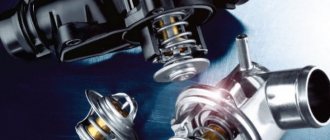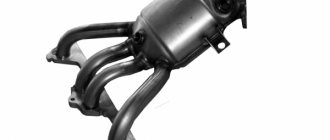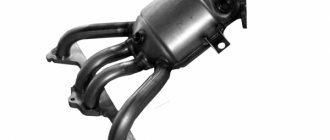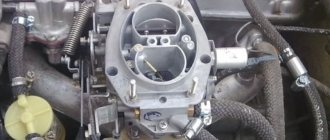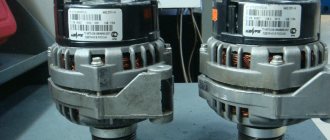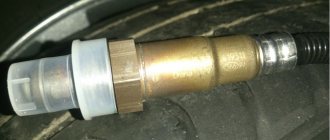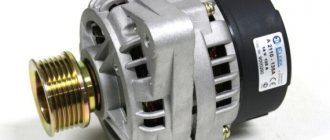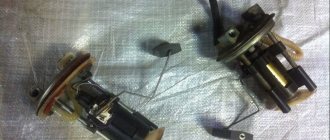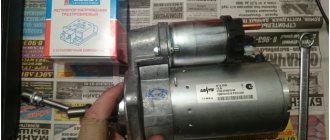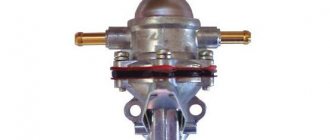Catalyst for VAZ 2115
Every owner of a "tag" at some point faces a problem with a catalyst. And then he needs an urgent replacement of the catalyst on the VAZ 2115. The old muffler often even sags so low that it clings to everything that lies incorrectly on the road surface. Of course, you can use fixing straps or wire, but this will not help. In any case, the VAZ 2115 catalyst needs to be replaced.
Description of the VAZ-2115 catalyst
As you know, the catalyst is one of the most important elements of the vehicle exhaust system.
Its purpose is to ensure the most complete combustion of hazardous substances released with exhaust gases. As a result, in theory, only water vapor and carbon dioxide should escape. It is also called a catalytic converter. Typically, the vast majority of car owners are not interested in such issues as environmental protection. For this reason, interest in the catalyst only arises when it stops working properly, that is, the ECU issues a certain error code during self-diagnosis. As practice shows, the catalyst installed on a VAZ-2115 car is a fairly reliable element and very rarely causes trouble. But sometimes you still have to replace it. At the same time, this matter cannot be postponed under any circumstances, because the car begins to perform noticeably worse. In addition, over time, the catalyst along with the exhaust pipe often sag almost to the ground. In this case, many try to fix it with improvised means, but the effect of such actions is negligible.
On average, the considered element of the exhaust system of a VAZ-2115 with an 8-valve engine remains operational until the car has driven 100 thousand kilometers.
Subsequently, it begins to interfere with the normal functioning of the power plant, because:
- oxidizes;
- gets clogged;
- it just collapses.
In reality, the durability of this unit is largely influenced by:
- quality of fuel used;
- the presence of various additives in it;
- degree of contamination.
This means that, in theory, the catalyst can be damaged after:
- several filling stations with counterfeit gasoline;
- failure of the mass air flow sensor or other control device that affects the composition of the air-fuel mixture.
Removing the catalyst on Niva 21214: consequences
Once removed, you will notice a significant increase in power. But let us immediately note that it will be within the factory values. After all, before this, the engine simply suffocated on its own gases and the power could drop by almost half. Gases will freely leave the combustion chamber - the risk of valve burnout is minimal.
Fuel consumption after removing the catalyst is within the factory values. But malfunctions will occur very rarely. After all, “when cold” the ECU is guided by average lambda values. And so on until the catalyst warms up. After removing it and flashing it, the unit will think that the neutralizer is already warmed up and will immediately begin to prepare the correct mixture.
The car will become less demanding on the quality of the fuel used. Even if there are deposits, all the dirt will fly straight into the pipe without being trapped in the filter honeycombs.
As for the negative aspects, after such “tuning” your environmental standards will immediately drop to Euro-2. But in Russia there are no penalties for this. It is completely legal to drive a Chevrolet Niva without a catalyst.
How to find out if the catalyst is clogged
To do this, you will need to perform a number of actions. Their order is as follows:
- remove the oxygen sensor;
- install a pressure gauge;
- check the pressure.
An indicator exceeding 0.5 atmospheres indicates that the catalyst is completely clogged and requires replacement. There is another way to determine the degree of congestion. In this case, it will be indicated by a failure of the oxygen sensor. Its breakdown or complete absence usually leads to the wrong mixture being supplied to the engine, which accelerates the clogging of the unit in question.
Problems are also indicated by a characteristic ringing sound that is heard inside the catalyst when it is tapped.
And finally, if the car has already traveled more than 100 thousand kilometers, then we can say with confidence that the unit has become unusable.
What can replace a catalyst
If the unit is completely clogged, it must be removed. You can install a new one or replace it with a blende (spacer). In essence, it is an empty shell. Ideal for cars with a one and a half liter engine. In most cases, you won't even need to update the ECU.
Some craftsmen drill holes in the catalyst or burn out all the filling installed inside with an autogen.
However, experts note that the most effective solution would be a spider. In fact, this element consists of several tubes connected together according to a special formula. Thus, if you do not care about the state of the environment, and the engine in your car is 1.5 liters, then it is enough to install a blende.
If the engine is 1.6 liters, you will have to buy a spider. The main thing is that it has a hole for one sensor.
It is worth understanding that such machines, as a rule, have software developed for the Euro-3 standard. It is because of this that there is a high probability that the computer will most likely generate an error. However, there is nothing wrong with this - just flash the ECU for Euro-2, and the problem will be eliminated.
Source
Replacement on a 16-valve engine
In the case of a 16-valve power unit, the catalyst is included in the design with the output manifold. Therefore, look for it behind the cylinder block directly in the engine compartment.
The nuance of dismantling the 16-valve engine is the presence of two lambdas.
- The first is located directly on the catalyst. It serves to adjust the fuel mixture;
- The second is located on the flange after the device. It is called ecological. If this lambda is not in place, the sensor will immediately generate an error, the injection will stop working properly, thrust will increase and fuel consumption will increase.
There are two ways to solve this issue:
- If you bought a spider for one regulator, the electronic control unit can be upgraded to Euro 2 from the current Euro 3. But such a spider has a serious drawback - the only thread for the lambda is on the flange. To mount the injection lambda there, you will have to assemble an extension cord from a wire and two connectors, called mother-father.
- If it is a spider with two regulators, the injection lambda is mounted in a standard socket. The thread for the second sensor is plugged or a dummy for the electronic control unit is installed in its place. In the second situation, there is no need to reflash the ECU.
Replacing the catalyst on a VAZ 2115 - we do everything ourselves
Every owner of a "tag" at some point faces a problem with a catalyst. And then he needs an urgent replacement of the catalyst on the VAZ 2115. The old muffler often even sags so low that it clings to everything that lies incorrectly on the road surface. Of course, you can use fixing straps or wire, but this will not help. In any case, the VAZ 2115 catalyst needs to be replaced.
Why do you need a catalyst?
Usually, when it comes to a catalyst, most motorists only think of a muffler, or rather a can or pipe. In fact, the exhaust system of a car includes several elements: connecting pipes, muffler, resonator, corrugation, catalyst, etc. So:
- The catalytic converter, as the catalyst is called, is a fairly important element of the car and the entire exhaust system.
- One of the main functions assigned to it is the purification of exhaust gases that flow through the pipe. The latest Euro 2 standards require the presence of a catalyst in the exhaust system of the car and a special oxygen sensor.
- The neutralizer itself, despite the fact that it is made of metal and a massive body, is a rather fragile element. He is afraid of severe mechanical damage, and is also quite sensitive to low-quality fuel. Impurities and various dirt residues contained in low-quality gasoline remain on the walls of the catalyst, gradually accumulate there and lead to damage to the part. In Russian conditions, the catalyst fails very quickly. And if, usually, it is designed for 200,000 km of run, then if it comes into daily contact with Russian fuel, it will not withstand even 30,000 km of run.
It is useful to know what a catalytic converter is made of. And find out how this part works. As was said, it reduces the amount of harmful substances and impurities that any car with an internal combustion engine emits into the surrounding atmosphere. These are substances dangerous to human health, such as carbon monoxide, nitrogen oxide, etc. For example, carbon monoxide is a real gas that has neither color nor odor. But it is precisely this that contributes to the appearance of cardiac colic and headaches in people. As for the design of the catalyst, it consists of a ceramic or often metal honeycomb part. Why honeycombs? Yes, because the design resembles a honeycomb. On top of these same honeycombs, special precious metals, most often platinum, are sprayed. Although palladium catalysts are often used in the automotive industry of developed countries.
Insert instead of catalyst VAZ 2114 8 valves
- To the beginning of the forum
- Forum Rules
- Old design
- FAQ
- Search
- Users
If the cat is working and you don’t plan to install anything other than a spider (a direct-flow resonator, a muffler) - then there are only disadvantages: flashing, you won’t pass MOT, at the post when measuring CO-CH they will take off the numbers
On the plus side, there may be an increase of 2-3 mares
Has anyone installed electronic decoys for a second oxygen sensor?
You put 4-2-1 Stinger without any Subaru sound
If I’m not mistaken, then “4-2-1” is structurally longer than “4-1”, and therefore will not fit with the original resonator
Added after 7 minutes 33 seconds:
Friends, thank you for your answer. I replaced my burnt-out catalyst with a regular no-name Spider “4-1” (1100 RUR.
), because I couldn’t find a stinger in the city, so I didn’t bother with delivery. I left the second sensor, screwing it into a mechanical snag. At the same time, I changed the receiver gaskets, cleaned the throttle body, and filled in new antifreeze, of course. I checked everything 10 times, on the first day I drove 6 kilometers around the city in different modes - quiet and fresh air in the cabin, even in my opinion the ride became better
Added after 9 minutes 26 seconds:
But the next day, after driving 10-15 km along the highway, a problem was revealed - it jerks in 3rd and higher gears, especially when “pulled” (uphill, at rpms less than 2000, etc.). At idle everything is fine - it holds the speed, you accelerate and it doesn’t stall. At first the fault was that the second oxygen sensor was not disconnected, but after disconnecting the connector nothing changes, moreover, the check does not light up. Looks like he's already switched off in his brain?
Friends, tell me what to do: 1) Measure the compression, check the quality of the gasket installation on the block? 2) Check the connection between the receiver and the inlet? 3) Or is there nothing to do with the mechanics and take the ELM327 into your hands and see what your brains see?
good coming from the very bottom.
and nothing bothered me. euro2 bosch.
Added after 5 minutes 58 seconds:
or find a Bosch 7.9.7 brain and sell yours.
Bosch is smoother. adapts better to imperfect hardware
Well, it wouldn’t hurt to measure the compression, of course.
Should the check light be on on the “factory” firmware if the second oxygen sensor is physically disconnected from the connector?
Probably some kind of “tune” has already been filled in of unknown quality and origin
Probably some kind of “tune” has already been filled in of unknown quality and origin
Damn, I thought so, judging by the way she reacts to the gas pedal. The last nine didn't have this. Thank you very much for your help. I won’t be able to flash it myself in the coming days. As soon as I manage to localize the problem, I’ll write back, maybe my experience will be useful to someone.
Added after 4 minutes 50 seconds:
Only, if the second oxygen sensor is already turned off, it turns out that the brain should not “see” that the catalyst is no longer there, which means it should drive the same way as before replacing the exhaust. And she began to twitch.
Where is the catalyst located in VAZ 2108 - 2115 cars, repair and replacement
The power unit has been modified to meet new environmental requirements. But this alone was not enough; a device was required that would burn the exhaust gases and reduce the content of toxic substances in them.
A catalyst (catalytic converter, catalytic converter, catalytic converter) is a device that reduces the toxicity of a passenger car exhaust, making it more environmentally friendly. The catalyst in the VAZ 2114 car is located in the engine compartment, so if necessary, it can be removed and replaced independently.
Replacement on a 16-valve engine
In the case of a 16-valve power unit, the catalyst is included in the design with the output manifold. Therefore, look for it behind the cylinder block directly in the engine compartment.
The nuance of dismantling the 16-valve engine is the presence of two lambdas.
- The first is located directly on the catalyst. It serves to adjust the fuel mixture;
- The second is located on the flange after the device. It is called ecological. If this lambda is not in place, the sensor will immediately generate an error, the injection will stop working properly, thrust will increase and fuel consumption will increase.
There are two ways to solve this issue:
- If you bought a spider for one regulator, the electronic control unit can be upgraded to Euro 2 from the current Euro 3. But such a spider has a serious drawback - the only thread for the lambda is on the flange. To mount the injection lambda there, you will have to assemble an extension cord from a wire and two connectors, called mother-father.
- If it is a spider with two regulators, the injection lambda is mounted in a standard socket. The thread for the second sensor is plugged or a dummy for the electronic control unit is installed in its place. In the second situation, there is no need to reflash the ECU.
Why do you need a catalyst?
By the mid-90s of the twentieth century, cars of the Samara family, equipped with carburetor engines, could no longer compete with foreign cars, the flow of which poured into Russia from abroad.
Therefore, the management had to make a decision to replace the carburetor engine with a more modern power unit that meets the requirements of Euro-1 and Euro-2. This engine was the VAZ 2111 power unit, which, like the carburetor VAZ 2110 that appeared a little earlier, was a modification of the popular VAZ 21083 engine.
The most dangerous toxic substance was carbon monoxide (carbon monoxide), which in order to be converted into harmless carbon dioxide must be burned again, in other words, mixed with oxygen at a high temperature.
This is what the catalyst in the VAZ 2110 and other models is designed for - it burns carbon monoxide, turning it into harmless carbon dioxide, and also burns other unburnt remains of motor fuel, for example, tars or various oils.
Solution
In fact, the cleaning element itself cannot be repaired. Only replacement is possible. And this is where the fun begins. Many car owners simply refuse to replace a faulty converter with a new one. The main reason for this is the high price. Sometimes it exceeds the residual value of the car. The quality of the fuel also plays an important role.
Most car enthusiasts use a simple and inexpensive replacement method - install a flame arrester instead of a catalyst. This device almost completely replaces the neutralizer. The only drawback is that there will be slightly more harmful impurities in the exhaust. But within the limits of the norms accepted in Russia. Moreover, the installation of a flame arrester is officially permitted by the relevant authorities.
There is another option for replacing the catalyst - installing an insert, or “spider”. This is also an approved replacement device. Like flame arresters, it is produced by industrial factories. It has several varieties for different engines. The main difference is in the product configuration.
How does a catalytic converter work?
Exhaust gases passing through the holes of the catalyst honeycomb heat it. When the temperature reaches several hundred degrees, a thin coating of platinum and other metals begins to have a catalytic effect, forcing molecules of carbon monoxide and other unburnt fuel residues to react with oxygen. This reaction leads to the release of even more heat, causing the converter to heat up to a temperature of 500–700 degrees.
Any malfunction of the fuel system, engine or ignition, as well as frequent sudden starts, lead to an increase in fuel injection into the cylinders, which means that there are also more unburnt residues. Because of this, not all molecules bind to oxygen molecules; some of them settle on the walls of the holes of the catalytic converter, and this process is especially strong during warm-up of the engine.
To some extent, it helps to clean the channels by driving at high engine speeds with the gas pedal pressed minimally, when the number of unburned particles is minimal, and the amount of oxygen and exhaust temperature are maximum. Under such conditions, even the residues deposited on the walls react with oxygen, turning into carbon dioxide, but some of the slag still remains in place.
How does this part work?
The barrel-shaped catalyst body is made of stainless, heat-resistant steel, thanks to which it can withstand high temperatures (500–800 degrees). From the front side it includes four exhaust manifold pipes, through which fuel combustion products enter the exhaust system.
A pipe is welded on the rear side, to which the exhaust pipe (muffler pipe) is connected. The catalyst itself is located inside the housing; it is made of ceramic and is pierced with through holes running along it, through which the exhaust passes.
Why do you need a catalyst?
From the front and back, the removed catalytic element looks like a fine-mesh honeycomb, the holes in which can be seen if you look through it into the light, but this only works with new catalysts.
In addition, holes are made in the front and rear parts of the body for oxygen sensors, which are also called lambda probes. They evaluate the amount of oxygen in the exhaust gases before and after the catalyst, then transmit the data to the electronic control unit (ECU, controller), which, based on this information, adjusts the amount of fuel supplied to the cylinders.
How does a catalyst differ from a flame arrester?
The task of the flame arrester is to reduce the exhaust volume and burn out excess fuel that is not burned in the cylinder, so it cannot reduce toxicity. If you install it instead of a catalytic converter, then not only will the exhaust toxicity increase, but the engine will also not work properly, because the ECU will reduce the fuel supply so that the amount of oxygen at the output of the device approaches the norm.
When the catalyst on a VAZ 2114 car is removed to install a flame arrester, you have to either use “decoys” that simulate the operation of lambda probes, or change the firmware of the control unit so that it does not take into account the readings of these sensors.
What can a damaged catalyst cause?
If the catalytic converter is only clogged with soot, it can still be cleaned. But if you do not pay attention to the problem that has arisen, then in the best case, the car simply will not be able to start one day, or the engine will start, but quickly stall.
It’s worse if the reel melts due to soot. It will not be possible to restore the damaged element, then either replacing the catalytic converter or removing it and installing a flame arrester will help restore engine performance.
The worst option is mechanical destruction. Honeycomb particles can significantly impede the passage of exhaust gases through the catalyst.
Because of this, some of the gases can return back to the cylinders, and even with ceramic impurities.
And foreign objects in the cylinders, even small ones, can lead to damage to the cylinder-piston group and the need for major repairs.
But you shouldn’t always “sin” on the catalyst; it can only be a consequence of the fact that one of the car systems is not working correctly, or low-quality fuel with a large number of additives is poured into the car.
Therefore, even with the slightest drop in power, you should immediately diagnose the state of the power and ignition systems, as well as evaluate the performance of all sensors, and only then check the catalyst.
Why is there not a catalytic converter on all VAZ 2108-2115 models?
Early models of these cars were produced with carburetor engines, for which this part is not required. Then the first injection models appeared, on which a catalyst with one oxygen sensor was installed. As the technology of injection power units was mastered, catalysts with two lambda probes began to be installed.
How to find out if a catalytic converter is worth it
Therefore, a catalyst in a VAZ 2114 car is needed if the vehicle is equipped with an injector; carburetor cars are not subject to European environmental requirements, which means there is no point in installing an expensive part.
Where is the catalytic converter located?
The location of this part depends on the engine type and vehicle model. On the Samara-1 family (VAZ 2108–21099) with an eight-valve VAZ 2111 engine, it is located behind the power unit, therefore, due to its location, it is often called a catcollector, that is, a collector and a catalyst. On the “tenth” family (VAZ 2110–2112) equipped with 1.5 liter engines under the bottom of the car, equipped with 1.6 liter engines behind the power unit. On the Samara-2 family (VAZ 2113–2115) the same as on the tenth family.
In addition, it is not uncommon for cars of other series to be converted from eight-valve to sixteen-valve engines. After each such alteration, it is necessary to change the catalyst to a more suitable one, that is, for Euro-4 and 2 oxygen sensors.
Replacing a device on a 16-valve engine
Catalyst for a 16-valve engine
In this case, the catalyst is located together with the exhaust manifold, and you should look for it under the hood of the car, in the immediate vicinity of the cylinder block. To replace the unit, we need a catalyst with zero resistance, or – as it is popularly called – a “spider”. It is quite possible to replace the device in your own garage. The first nuance when replacing a unit is dismantling the fuel rail. The second is the presence of two lambda probes. The first is located directly on the catalyst and is responsible for setting up the fuel system. The second one is located after it, on the flange. Very often it is called “ecological”. If the lambda malfunctions, the sensor generates an error and fuel injection begins to work incorrectly, resulting in an increase in traction and, accordingly, fuel consumption. There are also two ways to solve this problem. The first is to purchase a “spider” with one regulator and flash the electronics unit from Euro-3 to Euro-2. But there is one BUT, there is only one thread on such a spider, and it is on the flange. This means that to install the device you will have to assemble an extension cord consisting of wires and two connectors, popularly called “male and female”. The second is to purchase a “spider” with two regulators and simply install it in its regular place. In this case, there is no need to reconfigure the electronics.
Articles and prices
On VAZ 2108–2115, 3 types of catalytic converters are installed: under
- Euro-2 8 valves;
- for Euro-3 and Euro-4 8 valves;
- for Euro-3 and Euro-4 16 valves.
Part number for Euro-2 is 21100120601011, average cost is 4 thousand rubles. The main difference is one hole for the oxygen sensor. This part cannot be installed on cars with Euro-3 and Euro-4 engines, because there is nowhere to install the second lambda probe. Neutralizers for Euro-3 and Euro-4 for eight-valve engines are similar in design to the previous ones, but are equipped with two holes for oxygen sensors, their article number is 11183-1203008, the average cost is 6 thousand rubles.
Neutralizers for 16V engines (this is how the number of valves is designated) are the same not only for all VAZ 2108-2115 models, but also for their modern descendants. Part number 11186-1203008, average cost 10 thousand rubles. Remember, converters for 8V and 16V motors are not interchangeable because they are installed in different places.
Malfunctions
Here are the catalytic converter faults:
- the holes are clogged;
- the filter elements have come off the housing;
- the body burned out.
The main sign that the holes are clogged is a decrease in the power of the power unit, because the engine has to spend much more energy pushing exhaust gases through the converter.
The vehicle has trouble picking up speed, has difficulty going uphill, and sometimes won't start. In such situations, car owners often ask the question whether a catalyst is needed in the exhaust system of a VAZ 2114 or other models, since they negatively affect the behavior of the vehicle. They forget that the catalytic converter only lasts for a certain time, after which it needs to be replaced.
The main sign that the filter elements have become detached from the body is an increasing noise level, to which are added barely audible rattling sounds. This malfunction slightly reduces the efficiency of the device, because part of the exhaust gases bypasses the ceramic filling, in addition, the risk of burning out the housing increases sharply.
Signs of housing burnout are:
- sharply increased engine volume;
- unpleasant smell in the cabin;
- increased exhaust toxicity.
Almost always, a burnout of the body occurs after the appearance of both previous faults, so it is impossible to fully restore the part, and a patch applied to the burnout site will only reduce the noise level and unpleasant odor in the cabin.
How to check
If you suspect that the catalytic converter is faulty, then do the following:
- remove it from the car (to do this, on eight-valve cars you will have to remove the exhaust manifold);
- look at the gap, if you cannot see the light due to the shape of the device, then in a dark room place a bright flashlight at the outlet so that the light goes only into the device; if the reflection of light from the walls of the collector is dim, the catalyst is clogged;
- shake it and listen to see if the ceramic inserts rattle; if they rattle, then they have come off the body;
- turn the part over with its back side facing you and inspect the surface of the ceramic filler, if it is intact, everything is fine, but if it is cracked or collapsed, the neutralizer needs to be changed;
- inspect the body for burns and dark spots; if there are any, the device needs to be replaced.
